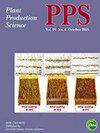Estimation of spikelet number per area by UAV-acquired vegetation index in rice (Oryza sativa L.)
IF 1.3
3区 农林科学
Q2 AGRONOMY
引用次数: 3
Abstract
ABSTRACT The objectives of this study were to find the best vegetation index (VI) associated with plant nitrogen content at the reproductive stage in rice, to associate the number of spikelets with this VI and solar radiation, and to estimate the number of spikelets. Rice cultivars Ishikawa 65 and Koshihikari were grown in the field in 2019 and 2020 at various nitrogen application rates and transplanting densities. From 30 days before heading to just after heading, the field was imaged with a multispectral camera. The images were processed with predefined ground control point data to create VI maps. From the maps, VI data were retrieved from the canopy area where plants were harvested for the determination of plant nitrogen content at the reproductive stage and of the number of spikelets at maturity. Among 6 VIs tested, the chlorophyll index green (CIgreen) had the highest coefficient of determination (R 2) with plant nitrogen content at the reproductive stage and was the only VI with a linear relation with plant nitrogen content. The number of spikelets per unit area was well explained by multiple regression with CIgreen at 15 days before heading (CIG15) and cumulative solar radiation in the 15 days before heading (CSR15) as independent variables. A higher CIG15 would increase the number of spikelets differentiated and a higher CSR15 would reduce the rate of degeneration by increasing dry matter production. Graphical abstract利用无人机植被指数估算水稻每面积颖花数
摘要本研究的目的是寻找与水稻生殖阶段植物氮含量相关的最佳植被指数(VI),将小穗数与该指数和太阳辐射量联系起来,并估计小穗数。2019年和2020年,水稻品种石川65和Koshihikari在不同的施氮率和移植密度下在田间种植。从出发前30天到出发后,用多光谱相机对该区域进行了成像。使用预定义的地面控制点数据对图像进行处理,以创建VI地图。从地图中,从收获植物的冠层区域检索VI数据,用于确定繁殖阶段的植物氮含量和成熟时的小穗数。在6个VI中,叶绿素指数绿色(CIgreen)与生殖期植物氮含量的决定系数(R2)最高,是唯一与植物氮含量呈线性关系的VI。单位面积小穗数通过多元回归得到了很好的解释,抽穗前15天的CIgreen(CIG15)和抽穗前15日的累积太阳辐射(CSR15)是自变量。较高的CIG15将增加分化的小穗数量,而较高的CSR15将通过增加干物质产量来降低退化率。图形摘要
本文章由计算机程序翻译,如有差异,请以英文原文为准。
求助全文
约1分钟内获得全文
求助全文
来源期刊

Plant Production Science
农林科学-农艺学
CiteScore
5.10
自引率
4.00%
发文量
27
审稿时长
>36 weeks
期刊介绍:
Plant Production Science publishes original research reports on field crops and resource plants, their production and related subjects, covering a wide range of sciences; physiology, biotechnology, morphology, ecology, cropping system, production technology and post harvest management. Studies on plant production with special attention to resource management and the environment are also welcome. Field surveys on cropping or farming system are also accepted. Articles with a background in other research areas such as soil science, meteorology, biometry, product process and plant protection will be accepted as long as they are significantly related to plant production.
 求助内容:
求助内容: 应助结果提醒方式:
应助结果提醒方式:


